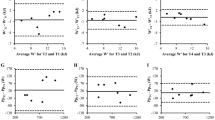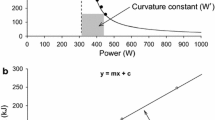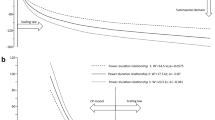Abstract
This study examined the effect of end-point cadence on the parameters of the work-time relationship determined for cycle ergometry. Eight male subjects completed four maximal tests on an electrically-braked cycle ergometer that regulated a constant power output independent of cadence. The power outputs imposed ranged between an average of 259 W and 403 W, whereas the corresponding durations ranged between 139 s and 1691 s. During each test subjects were required to maintain a cadence of 80–90 rpm. Accumulated time to end-point cadences of 70, 60 and 50 rpm were recorded. The four work-time determinations for each of three end-point cadences were used to determine linear relationships between work and time, yielding both a y-intercept, which represents anaerobic work capacity, and a slope, which is termed critical power (CP), for each end-point cadence. There was a significant increase in the y-intercept as end-point cadence decreased from 70 to 60 rpm (F[1,7]=36.7, p < 0.001) or 70 to 50 rpm (F[1,7]=80.1, p < 0.001), but not from 60 rpm to 50 rpm (F[1,7]=3.28, p > 0.05). In contrast, there was no effect of end-point cadence on CP (F[2,14]=1.89, p < 0.05). These results demonstrate that the end-point cadence selected to terminate tests only affects the y-intercept of the work-time relationship. To control for this effect, the cadence at which each test is terminated should be standardised if determination of anaerobic work capacity, as represented by the y-intercept, is required.
Similar content being viewed by others
References
Di Prampero PE, Boutellier U, Marguerat A (1988) Efficiency of work performance and contraction velocity in isotonic tetani of frog sartorius. Pflügers Arch 412:455–461
Green S, Dawson BT, Goodman C, Carey MF (1994) Y-intercept of the maximal work duration relationship and anaerobic capacity in cyclists. Eur J Appl Physiol 69(6):550–556
Hill DW (1993) The critical power concept. Sports Med 16(4):237–254
Hill DW, Smith JC, Leuschel JL, Chasteen SD, Miller SA (1995) Effect of pedal cadence on parameters of the hyperbolic power-time relationship. Int J Sports Med 16(2):82–87
Housh DJ, Housh TJ, Bauge SM (1990) A methodological consideration for the determination of critical power and anaerobic work capacity. Res Quart 61(4):406–409
Luhtanen P, Rahkila P, Rusko H, Viitasalo JT (1987) Mechanical work and efficiency in ergometer cycling at aerobic and anaerobic thresholds. Acta Physiol Scand 131:331–337
Monod H, Scherrer J (1965) The work capacity of a synergic muscular group. Ergonomics 8:329–338
Poole DC (1986) Letter to the editor-in-chief. Med Sci Sports Exerc 18(6):703–704
Author information
Authors and Affiliations
Rights and permissions
About this article
Cite this article
Green, S., Bishop, D. & Jenkins, D. Effect of end-point cadence on the maximal work-time relationship. Eur J Appl Physiol 71, 559–561 (1995). https://doi.org/10.1007/BF00238561
Accepted:
Issue Date:
DOI: https://doi.org/10.1007/BF00238561




